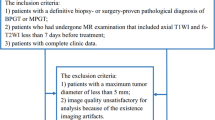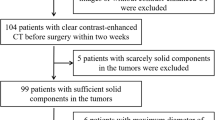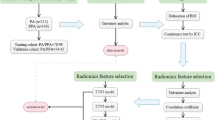Abstract
Objectives
The differentiation of Warthin tumor and pleomorphic adenoma before treatment is crucial for clinical strategies. The aim of this study was to develop and test a T2-weighted-based radiomics model for differentiating pleomorphic adenoma from Warthin tumor of the parotid gland.
Methods
A total of 117 patients, including 61 cases of Warthin tumor and 56 cases of pleomorphic adenoma, were retrospectively enrolled from two centers between January 2010 and June 2022. The training set included 82 cases, and the validation set included 35 cases. From T2-weighted images, 971 radiomics features were extracted. Seven radiomics features remained after a two-step selection process. We used the seven radiomics features and clinical factors through multivariable logistic regression to build radiomics and clinical models, respectively. A radiomics–clinical model was also built that combined the independent clinical predictors with the radiomics features. Through ROC curves, the three models were evaluated and compared.
Results
In the radiomics model, AUCs were 0.826 and 0.796 in training and validation sets, respectively. In the clinical model, the AUCs were 0.923 and 0.926 in the training and validation sets, respectively. Decision curve analysis revealed that the radiomics–clinical model had the best diagnostic performance for distinguishing Warthin tumor from pleomorphic adenoma of the parotid gland (AUC = 0.962 and 0.934 for the training and validation sets, respectively).
Conclusion
The radiomics–clinical model performed well in differentiating pleomorphic adenoma from Warthin tumor of the parotid gland.
Key points
• The clinical model outperformed the radiomics model in distinguishing pleomorphic adenoma from Warthin tumor of the parotid gland.
• The radiomics features extracted from T2-weighted images could help differentiate pleomorphic adenoma from Warthin tumor of the parotid gland.
• The radiomics–clinical model was superior to the radiomics and the clinical models for differentiating pleomorphic adenoma from Warthin tumor of the parotid gland.






Similar content being viewed by others
Change history
23 December 2022
A Correction to this paper has been published: https://doi.org/10.1007/s00330-022-09371-5
Abbreviations
- AUC:
-
Area under the curve
- CT:
-
Computed tomography
- ICC:
-
Intraclass correlation coefficient
- LASSO:
-
Least absolute shrinkage and selection operator
- MRI:
-
Magnetic resonance imaging
- PA:
-
Pleomorphic adenoma
- ROI:
-
Region of interest
- SI:
-
Signal intensity
- T1WI:
-
T1-weighted image
- T2WI:
-
T2-weighted image
- WT:
-
Warthin tumor
References
Tunç O, Gönüldaş B, Arslanhan Y, Kanlıkama M (2020) Change in Warthin's tumor incidence: a 20-year joinpoint trend analysis. Eur Arch Otorhinolaryngol 277:3431–3434
Abu-Ghanem Y, Mizrachi A, Popovtzer A, Abu-Ghanem N, Feinmesser R (2016) Recurrent pleomorphic adenoma of the parotid gland: institutional experience and review of the literature. J Surg Oncol 114:714–718
Quer M, Hernandez-Prera JC, Silver CE et al (2021) Current trends and controversies in the management of Warthin tumor of the parotid gland. Diagnostics (Basel) 11:1467
Mehanna H, McQueen A, Robinson M, Paleri V (2012) Salivary gland swellings. BMJ 345:e6794
Suzuki M, Kawata R, Higashino M et al (2019) Values of fine-needle aspiration cytology of parotid gland tumors: a review of 996 cases at a single institution. Head Neck 41:358–365
Matsuda E, Fukuhara T, Donishi R, Kawamoto K, Hirooka Y, Takeuchi H (2017) Usefulness of a novel ultrasonographic classification based on anechoic area patterns for differentiating warthin tumors from pleomorphic adenomas of the parotid gland. Yonago Acta Med 60:220–226
Yamamoto T, Kimura H, Hayashi K, Imamura Y, Mori M (2018) Pseudo-continuous arterial spin labeling MR images in Warthin tumors and pleomorphic adenomas of the parotid gland: qualitative and quantitative analyses and their correlation with histopathologic and DWI and dynamic contrast enhanced MRI findings. Neuroradiology 60:803–812
Jung YJ, Han M, Ha EJ, Choi JW (2020) Differentiation of salivary gland tumors through tumor heterogeneity: a comparison between pleomorphic adenoma and Warthin tumor using CT texture analysis. Neuroradiology 62:1451–1458
Rong X, Zhu Q, Ji H, Li J, Huang H (2014) Differentiation of pleomorphic adenoma and Warthin's tumor of the parotid gland: ultrasonographic features. Acta Radiol 55:1203–1209
Eravcı FC, Sözmen Cılız D, Özcan KM et al (2020) Conventional and diffusion-weighted MR imaging findings of parotid gland tumors. Turk Arch Otorhinolaryngol 58:174–180
Cappabianca S, Capasso R, Cirillo M, Santagata M, Tartaro G, Colella G (2013) Dynamic evaluation of benign neoplasm of parotid glands with multidetector row CT. Minerva Stomatol 62:95–106
Lambin P, Leijenaar RTH, Deist TM et al (2017) Radiomics: the bridge between medical imaging and personalized medicine. Nat Rev Clin Oncol 14:749–762
Bezzi C, Mapelli P, Presotto L et al (2021) Radiomics in pancreatic neuroendocrine tumors: methodological issues and clinical significance. Eur J Nucl Med Mol Imaging 48:4002–4015
Wu G, Woodruff HC, Shen J et al (2020) Diagnosis of invasive lung adenocarcinoma based on chest CT radiomic features of part-solid pulmonary nodules: a multicenter study. Radiology 297:451–458
Jamet B, Morvan L, Nanni C et al (2021) Random survival forest to predict transplant-eligible newly diagnosed multiple myeloma outcome including FDG-PET radiomics: a combined analysis of two independent prospective European trials. Eur J Nucl Med Mol Imaging 48:1005–1015
Yuan G, Song Y, Li Q et al (2020) Development and validation of a contrast-enhanced CT-based radiomics nomogram for prediction of therapeutic efficacy of anti-PD-1 antibodies in advanced HCC patients. Front Immunol 11:613946
Antunovic L, De Sanctis R, Cozzi L et al (2019) PET/CT radiomics in breast cancer: promising tool for prediction of pathological response to neoadjuvant chemotherapy. Eur J Nucl Med Mol Imaging 46:1468–1477
Zheng YM, Li J, Liu S et al (2021) MRI-based radiomics nomogram for differentiation of benign and malignant lesions of the parotid gland. Eur Radiol 31:4042–4052
Song LL, Chen SJ, Chen W et al (2021) Radiomic model for differentiating parotid pleomorphic adenoma from parotid adenolymphoma based on MRI images. BMC Med Imaging 21:54
Gabelloni M, Faggioni L, Attanasio S et al (2020) Can magnetic resonance radiomics analysis discriminate parotid gland tumors? A pilot study. Diagnostics (Basel) 10:900
Zheng YM, Chen J, Xu Q et al (2021) Development and validation of an MRI-based radiomics nomogram for distinguishing Warthin's tumour from pleomorphic adenomas of the parotid gland. Dentomaxillofac Radiol 50:20210023
Vernuccio F, Arnone F, Cannella R et al (2021) Diagnostic performance of qualitative and radiomics approach to parotid gland tumors: which is the added benefit of texture analysis? Br J Radiol 94:20210340
Eveson JW (2011) Salivary tumours. Periodontol 2000(57):150–159
Cannella R, Fraum TJ, Ludwig DR et al (2021) Targetoid appearance on T2-weighted imaging and signs of tumor vascular involvement: diagnostic value for differentiating HCC from other primary liver carcinomas. Eur Radiol 31:6868–6878
Caglic I, Povalej Brzan P, Warren AY, Bratt O, Shah N, Barrett T (2019) Defining the incremental value of 3D T2-weighted imaging in the assessment of prostate cancer extracapsular extension. Eur Radiol 29:5488–5497
Fruehwald-Pallamar J, Czerny C, Holzer-Fruehwald L et al (2013) Texture-based and diffusion-weighted discrimination of parotid gland lesions on MR images at 3.0 tesla. NMR Biomed 26:1372–1379
Christe A, Waldherr C, Hallett R, Zbaeren P, Thoeny H (2011) MR imaging of parotid tumors: typical lesion characteristics in MR imaging improve discrimination between benign and malignant disease. AJNR Am J Neuroradiol 32:1202–1207
Yushkevich PA, Piven J, Hazlett HC et al (2006) User-guided 3D active contour segmentation of anatomical structures: significantly improved efficiency and reliability. Neuroimage 31:1116–1128
Bartko JJ (1991) Measurement and reliability: statistical thinking considerations. Schizophr Bull 17:483–489
Alhamzawi R, Ali HTM (2018) The Bayesian adaptive lasso regression. Math Biosci 303:75–82
R Core Team (2021). R: a language and environment for statistical computing. R Foundation for Statistical Computing, Vienna. Available via https://www.R-project.org/. Accessed 10 Jun 2022.
Rossum GV Jr, Drake FL (2009) Python 3 reference manual: (python documentation manual part 2), 3rd edn. CreateSpace Independ, North Charleston
Wang CW, Chu YH, Chiu DY et al (2018) JOURNAL CLUB: the Warthin tumor score: a simple and reliable method to distinguish warthin tumors from pleomorphic adenomas and carcinomas. AJR Am J Roentgenol 210:1330–1337
Colella G, Biondi P, Itro A, Compilato D, Campisi G (2010) Warthin's tumor distribution within the parotid gland. A feasible etiologic source from lymph nodal tissue. Minerva Stomatol 59(245-249):250–242
Patel DK, Morton RP (2016) Demographics of benign parotid tumours: Warthin's tumour versus other benign salivary tumours. Acta Otolaryngol 136:83–86
Kawata R, Terada T, Lee K, Higashino M, Ichihara S (2016) Surgical management for benign parotid tumors: review of a 16-year experience with 633 patients. Nihon Jibiinkoka Gakkai Kaiho 119:196–203
Wei P, Shao C, Tian M et al (2021) Quantitative analysis and pathological basis of signal intensity on T2-weighted MR images in benign and malignant parotid tumors. Cancer Manag Res 13:5423–5431
Shao S, Zheng N, Mao N et al (2021) A triple-classification radiomics model for the differentiation of pleomorphic adenoma, Warthin tumour, and malignant salivary gland tumours on the basis of diffusion-weighted imaging. Clin Radiol 76:472.e411–472.e418
Iima M, Partridge SC, Le Bihan D (2020) Six DWI questions you always wanted to know but were afraid to ask: clinical relevance for breast diffusion MRI. Eur Radiol 30:2561–2570
Jung JW, Kang HR, Kim MH et al (2012) Immediate hypersensitivity reaction to gadolinium-based MR contrast media. Radiology 264:414–422
Gillies RJ, Kinahan PE, Hricak H (2016) Radiomics: images are more than pictures, they are data. Radiology 278:563–577
Bera K, Braman N, Gupta A, Velcheti V, Madabhushi A (2022) Predicting cancer outcomes with radiomics and artificial intelligence in radiology. Nat Rev Clin Oncol 19:132–146
Aerts HJ, Velazquez ER, Leijenaar RT et al (2014) Decoding tumour phenotype by noninvasive imaging using a quantitative radiomics approach. Nat Commun 5:4006
Bharath AA, Ng J (2005) A steerable complex wavelet construction and its application to image denoising. IEEE Trans Image Process 14:948–959
Acknowledgements
We would like to thank Editage (www.editage.cn) for English language editing.
Author information
Authors and Affiliations
Corresponding authors
Ethics declarations
Guarantor
The scientific guarantor of this publication is Quan Zhou.
Conflict of interest
The authors of this manuscript declare no relationships with any companies whose products or services may be related to the subject matter of the article.
Statistics and biometry
One of the authors (Jiajun Feng) has significant statistical expertise.
Informed consent
Written informed consent was waived by the Institutional Review Board.
Ethical approval
Institutional Review Board approval was obtained.
Methodology
• retrospective
• diagnostic or prognostic study
• multicenter study
Additional information
Publisher’s note
Springer Nature remains neutral with regard to jurisdictional claims in published maps and institutional affiliations.
The original online version of this article was revised due to a retrospective Open Access cancellation.
Rights and permissions
Springer Nature or its licensor (e.g. a society or other partner) holds exclusive rights to this article under a publishing agreement with the author(s) or other rightsholder(s); author self-archiving of the accepted manuscript version of this article is solely governed by the terms of such publishing agreement and applicable law.
About this article
Cite this article
Hu, Z., Guo, J., Feng, J. et al. Value of T2-weighted-based radiomics model in distinguishing Warthin tumor from pleomorphic adenoma of the parotid. Eur Radiol 33, 4453–4463 (2023). https://doi.org/10.1007/s00330-022-09295-0
Received:
Revised:
Accepted:
Published:
Issue Date:
DOI: https://doi.org/10.1007/s00330-022-09295-0




